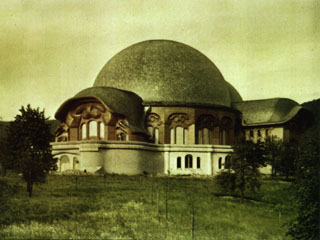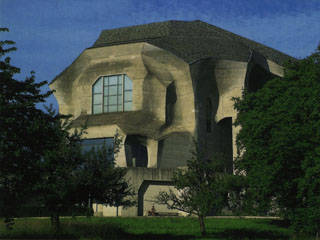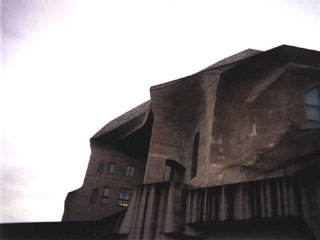|
when one enters a space, a room, one's feelings
take on the shape of
that room. for example, the shapes one takes on as one enters a gothic
arched vault would be different in nature than the shape one takes on
when one enters a square box...
the first and second goetheanum buildings (of 1919 and 1928 respectively),
can be found in the town of dornach, switzerland. architect -
rudolf steiner:
 view off goetheanum1 balcony view off goetheanum1 balcony
 goetheanum1 before burned down goetheanum1 before burned down
 goetheanum2 on the same site today goetheanum2 on the same site today
 goetheanum2 profile (JRP-1998)
for more pictures, click here. goetheanum2 profile (JRP-1998)
for more pictures, click here.
--| On the Form of the Goetheanum Building |-----
Concerning what is really involved here the important point is not that on
the one hand we preach to the sensuous gratification of our souls, and on
the other conduct ourselves according to the inevitable demands of the
life-routine that has developed through the last three or four centuries.
And few people are particularly inclined to go into this fundamental
problem of the present time. Why is this? It is because this dualism
between the external life and our so-called spiritual strivings has really
invaded life, and it has become very strong in the last three or four
centuries. Most people today when speaking of the spirit mean something
entirely abstract, foreign to the world, not something which has the power
to lay hold of daily life.
The question, the problem, which is indicated here must be attacked at its
roots. If we here on this hill had acted in the spirit of these tendencies
of the last three or four hundred years, then we would have employed any
kind of architect, perhaps a celebrated architect, and have had a
beautiful building erected here, which certainly could have been very
beautiful in any architectural style. But that was entirely out of the
question; for then, when we entered this building, we should have been
surrounded by all kinds of beauty of this style or that, and we should
have said in it things corresponding to the building-indeed, in about the
same way that all the beautiful speeches made today correspond with the
external life which people lead. That could not be, because the spiritual
science which intends to be anthroposophically orientated had no such
purpose.. From the beginning its aim was different. It intended to avoid
setting up the old false contrast between spirit and matter, whereby
spirit is treated in the abstract, and has no possibility of penetrating
into the essence and activity of matter. When do we speak legitimately of
the spirit? When do we speak truly of the spirit ? We speak truly of the
spirit, we are justified in speaking of the spirit, only when we mean the
spirit as creator of the material. The worst kind of talk about the spirit
- even though this talk is often looked upon today as very beautiful - is
that which treats the spirit as though it dwelt in Utopia, as if this
spirit should not be touched at all by the material. No; when we speak of
the spirit, we must mean the spirit that has the power to plunge down
directly into the material. And when we speak of spiritual science, this
must be conceived not only as merely rising above nature, but as being at
the same time valid natural science. When we speak of the spirit, we must
mean the spirit with which the human being can so unite himself as to
enable this spirit, through man's mediation, to weave itself even into the
social life. A spirit of which one speaks only in the drawingroom, which
one would like to please by goodness and brotherly love, but a spirit that
has no intention of immersing itself in our everyday life - such a spirit
is not the true spirit, but a human abstraction; and worship of such a
spirit is not worship of the real spirit, but is precisely the final
emanation of materialism.
Hence we had to erect a building which, in all its details, is conceived,
is envisioned, as arising out of that which lives in other ways as well in
our anthroposophically-orientated spiritual science. And with this is also
connected the fact that in this difficult time a treatment of the social
question has arisen from this spiritual science, which does not intend to
linger in Utopia, but which from the beginning of its activity intended to
be concerned with life; which intended to be the very opposite of every
kind of sectarianism; which intended to decipher that which lies in the
great demands of the time and to serve these demands. Certainly in this
building much has not succeeded, but today the matter of importance is
really not that everything shall be immediately successful, but that in
certain things a beginning, a necessary beginning be made; and at least
this essential beginning seems to me to have been made with this building.
And so, when it shall some day be finished, we shall accomplish what we
shall have to accomplish, not within something which would surround us
like strange walls; but just as the nutshell belongs to the nut-fruit and
is entirely adapted in its form to this nut-fruit, so will each single
line, each single form and colour of this building be adapted to that
which flows through our spiritual movement.
(Rudolf Steiner, The Michael Impulse - Lecture IX,
from The Mysteries of Light, of Space, and of the Earth).
 metamorphosis of column capitals in the first goetheanum
metamorphosis of column capitals in the first goetheanum
--| some personal observations on a visit to the goetheanum |-----
upon visiting in 1998, a brief recount of
an initial experience with this building.
i had the unique experience of discovering these buildings, almost by
accident. after reading steiner's philisophic works, i heard there was a
place which had a library, a theatre, and a bookstore. the town,
"Dornach", is a real pleasure to visit. coming from toronto -- one of the
cleaner cities north america for its size of population, here, i found a
place where people left their doors unlocked, and left their bikes out at
the train station during the day -- unlocked! i examined them for perhaps
another locking mechanism in the bike rack -- nothing, just left there.
coming from toronto, this was something rather amazing.
coming upon the site, the sheep grazing indicates some of the organic
farming activity about. this greets one soon aften one has wended one's
way through the clean streets of dornach, lined with various small art
studios and woodshops - a keenly fresh sense in the use of colour and
form. at the foot of the hill, one finds the 'spiesehaus' - a cavernous
cement building, with flowing lines - a certain sense of lightness in the
hanging of sweeping masses of concrete soaring upon the air. yet, a
functional use of concrete, as was the boiler-room haus (shaped with its
long chimney in cement to resemble a growing stalk from which the smoke
emerges, and a glasswork haus called "haus duldeck" -- most of the large
solid wood doors are set directly in concrete, and hand-hewn on the site.
so, i had heard the society which publishes this rudolf steiner's books,
had stressed keeping computers and televisions away from kids. this made
me curious, as being a bit of a computer afficando myself, i wondered how
would they handle electricity? would i find artistic luddites here? how
startled was i to encounter my first building - the 'transformer haus' - a
concrete affair, with this blue hue, and anglular electric appearance to
it. a veritable sculpture made of the utility building which housed the
electrical transformer for the site.
then beside it, the "speise" (food) haus - made in soft gastronmic shapes,
yet also out of these strange angles. the doorsteps flowing out around the
base of the step like cascading waters. simple, yet falling perfectly in
line with the path of a person passing through it. angles always reflected
back upon the observer. but this was a style that was made fully scalable
between large and small scale buildings. everything - from the transformer
haus, the boiler room, the benches, the steps, the doorknobs... all
consistently and thoroughly thought through, and imbued with a great deal
of craftsmanship. as i came upon the main building - the goetheanum, and
looking upon the hill where this building stands, how startled i was by
this concrete alighting itself, nestling itself in among the mountains
which surround it like it had always been there. the shapes of the
roofline inviting the birds to swoop up to it where the gusts of air
played together with the birds. concrete -- yet light and airy.
before i saw this building, i always had a preference for wood and stone.
as transient a material you use to make something with, so transient it
will last. the longer you want it to last, the better you got to build it
in the details and craftsmanship, because you're sticking people with it
for a long time. you build something worth lasting, for architecture - of
all the arts - is the one that we have to actually live in. this building
showed me that life can be brought into concrete as a building material.
so, given i just came here looking for a library. i found myself
surrounded and fascinated by how one responds to these SHAPES on an
inner-level. going through the spaces of this building, a serene calm of
this heavy weight of concrete lifted lightly into the air and transformed
into these floating shapes. i came looking for a library, of a
philosopher, and here before me stood an architect, with the most
incredibly fascinating shape i had ever seen constructed. from a
mathematical perspective, always the use of projective geometry; yet from
an artistic perspective, extremely organic. a building that has organic
dodechedrons, and for raw materials? just the cement itself. the floor,
the wall, the step, the railing all one piece of flowing forms of
eloquently formed concrete. concrete raised to a new level; transformed;
made light.
these buildings are quite unique in that they were created as a sort of
sound-stage, or theatre for the performance of EURTHYMY. what is eurythmy
you might ask? in a nutshell "VISIBLE SPEECH". they perform here several
times a year, and also the works of Goethe "Faust" with a stage ensemble.
they have invented new lighting systems and techniques to induce the moods
and feelings caused by subtle gradations and alterations of the tone of
colour in the whole background, and then without use of amplifiers (the
sound in this place is superb!) speech carries clearly and reverbrates in
these forms. sweeping across the the inside of the auditorium, a flowing
rendition in concrete of an organic metamorphosis in sound.
insofar as i can ascertain, every detail of these buildings has been
prepared on the principle: which proceeds first from the MOVEMENT, and
THEN THE SHAPE FORMS AROUND IT. in other words, if there is a door-knob,
the gesture used to reach for the door-knob is considered to be the very
basis for the shape the door knob is to be made.
when walking inside, the shapes are always like the movement of yourself
through intermittent stages of passing through a chamber, where always
through the subtle organic anglular formations yet the pentagon implied.
one feels very much like one is inside some great shining cavernous and
radiant creature by the treatment of the luminescent vegetable dyes on the
cement, and the shimmering rainbow of colours cast by the 2cm thick solid
panes of coloured of a single huge expanse of colour, and then etched with
illustrations in their surfaces so the gradations of that colour can be
exposed.
because the motion of everyday movements is anticipated in the
constructing of the shapes within this building, it gives you the most
uncanny sensation when you actually move around in these buildings, you
feel like "I FIT IN HERE". for example, when your hand comes off a
railing, the shape of the railing is made such that it follows the curve
made made by the hand coming off the railing. that's why i especially like
these buildings, they're not just eye-candy, but actually function very
practically in everyday use as well. it is very difficult to describe the
experience of these buildings without moving yourself through them; a
photograph does nothing to convey the aliveness these buildings
exhibit. i would well recommend a visit to any student of architecture to
these unique 1920's buildings.
through visiting this building, i have learned that every medium most be
used in its own unique way -- and also that a building medium should not
try and be what it is not. wood constructions should not be built in the
manner of stone construction; and every medium must exploit its unique
strengths. this building inspired me to whole new forms possible in the
medium of concrete.
It took some time, he said, for designers to recognize
the possibilities of the suspension bridge Ñ a form impossible
to create with stone alone but which was perfectly suited
to the properties of steel.
(Ivan Sutherland)
there's a few good books about this building:
http://www.anthropress.org/press/shop/books/1452.html
http://www.fto.de/fthp/rhesse/ag/goetherh.htm
http://www.archINFORM.de/medien/00000404.htm
regards,
john penner.
| 
